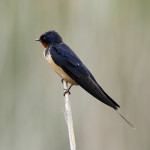• • •
Barn Swallows are almost aristocratic in appearance and flight, with a colorfully masked face, slender, pointed wings and long, forked tail. Their throat is a deep rust, with a cap of iridescent blue that streams down their back. A buff cinnamon chest contrasts with the rest of their dark plumage.
• Length: 6.75 inches
• Wingspan: 15 inches
• Season: Summer
More about Barn Swallows.
Where they are, and when.
Barn Swallows deftly swoop over fields or water with their wings and tail elegantly swept back, foraging for beetles, bees, butterflies and other flying insects. Sometimes, they’ll swallow small pebbles that may help in their digestion.
They are just about everywhere – from suburban parks and farms to lakes, cliffs and beaches. All they need is an open area to forage, structures to build their nests on and a source of mud for their construction.
Barn swallows have successfully adapted to life around civilization. They once built their nests on cliffs and and in caves, but now favor buildings, bridges and barns, hence their name. Their nests are cups of mud attached to a wall. They build them in layers by making hundreds of trips carrying mud in their bills, often mixed with grass.
If predators approach the nests, which are often in groups, they are liable to be attacked by a mob of Barn Swallows.
April 20, 2008
A group of barn swallows was darting about near the boardwalk at Anahuac National Wildlife Refuge. They would alight briefly on a reed and give me a quizzical look before launching back into their swooping attack on swarms of insects above the marsh. Every few minutes a dragonfly exchanged perches with the swallows. At first I assumed they were the meal that the swallows were pursuing, but there were a lot of other insects in the spring air, too. Perhaps the dragonflies were competing with the swallows for them. Were they hunters or the hunted? It was hard to tell.




You must be logged in to post a comment.